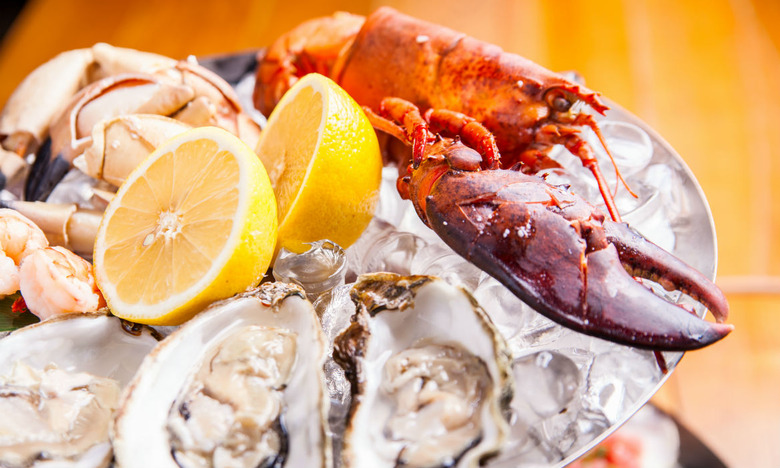How To Eat Messy Seafood Without Making A Fool Of Yourself
Eating seafood can often be an embarrassing, stressful, difficult experience. As much as we love dining on a fresh lobster, a bowlful of mussels, or some grilled prawns, eating them always induces a mini panic attack as we worry about how we're going to avoid making a complete fool of ourselves by approaching these crazy creatures all wrong. Make sure you don't embarrass yourself when you're dining on your favorite seafood ever again by following this mini guide.
Lobster
If you order lobster, it will probably be served to you cut in half down the middle. To begin with, eat the flesh from the body of the lobster: You can use your knife and fork to remove the meat or you can hold the shell with one hand, and pick out the flesh with just a fork.
For the remainder of the lobster, you need to use the tools you've been presented with. The most important part of the lobster to focus on, besides the main body, is its claws. Using the lobster crackers, press the big claws until they break. Then pull out the main chunk of flesh with a fork, and use the lobster pick to get in the nooks and crannies of the smaller parts.
Mussels
When you're presented with a bowl overflowing with plump mussels, it's so tempting to dive in immediately, picking up the shells with your hands, and simply slurping out the mussel from the shell. However, you should really approach these little shellfish slightly more delicately. Use an empty mussel shell as a pincer to extract the other mussels from their shells and transport them to your mouth. Or, be slightly less traditional, and swap the mussel shell for a fork. To eat the sauce swimming in the bottle of the bowl, mop it up with crunchy bread, or drink it with a spoon.
Once you've finished all the mussels, remember to clean your hands in the finger bowl. Dip in one hand at a time, gently rub your fingers in the water to remove any stickiness, and then dry them on your napkin.
Oysters
Oysters can be a daunting prospect, but they're actually one of the easiest shellfish to eat. Served on a bed of ice, oysters will have been shucked (detached from their shells) before being offered to you. If the oyster is still sticking to its shell, you can use your fork to carefully pull it away. Then squeeze some lemon over the oyster while it's still in its shell.
Now pick up the shell, and move the wide end towards your lips. Tip the shell upwards and slide the contents of it — oyster and juice all together — straight into your mouth. If that sounds a little too scary, hold the shell in your left hand, spear the oyster with a fork, eat it, and then drink the juices which remain in the shell, as described above. In terms of swallowing this slippery shellfish, it's totally acceptable to either swallow it whole, or to chew on it first.
Prawns
If your prawns are served to you still intact — shell on, and head and tail still in place — don't be scared. Begin by removing the head and the tail by pulling abruptly on each end. They'll come right off. Then peel off the shell, starting from the underside of the prawn where the legs are attached to the body. If it's proving tricky to remove the shell, gently bend the prawn backwards to loosen it — the shell will then come right off when you try again. Finally, remove the black thread along the back of the prawn before eating the flesh.
If the prawns are served with their heads and shells already removed, all you need to do is use the tail as a natural handle, and discard the tail once you've eaten the flesh. Clean your hands in the fingerbowl, one hand at a time, and dry them on your napkin.
